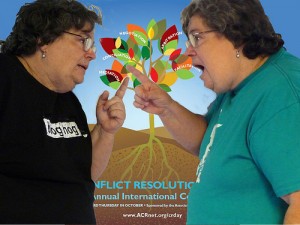 From my feeds (RSS, Twitter), I’ve recently come across some interesting goings on in the world of conflict/dispute resolution. And as much of it jives with my own experience and take on resolving conflicts, I thought I’d summarize, with a few examples, what I see as key factors impacting the practice of conflict resolution, going forward
From my feeds (RSS, Twitter), I’ve recently come across some interesting goings on in the world of conflict/dispute resolution. And as much of it jives with my own experience and take on resolving conflicts, I thought I’d summarize, with a few examples, what I see as key factors impacting the practice of conflict resolution, going forward
1. Information and Communication Technologies
- Self-help/assessment tools; e.g., an Iphone app to help you resolve your marital spat (developed by Mark McGonigle credit to Colin Rule for spotting this)
- Online Dispute Resolution (ODR): David Bilinsky gives an excellent summary of the themes that emerged from the 2010 ODR forum, recently held in Buenos Aires; including 1) need for education on ODR, 2) whether ODR will grow up within the legal system or parallel to it, 3) disputes using ODR are being impacted by demographics (as well as type of dispute), 4) potential benefit to the Third World, and 5) The World waits for No One (ouch!).
- Conflict prevention using GIS and social media; as reported at this May 2010 meeting at Google, London, where a new idea is floated: gathering SMS, images and video from the general public in areas of conflict (in the style of FrontlineSMS and Ushahidi), and combining that with satellite imagery to form a massive open database that could be accessed to help pressure key governments and others into preventative action.
- Conflict transformation; e.g., ICT for Peacebuilding, Santana Hattotuwa’s site in Sri Lanka; exploring the use of information and communications technology for conflict transformation
2. Youth involvement
- Around the world youth are seen as playing a Positive Role in Post-Conflict Reconstruction, in places such as Congo, Mozambique, Kosovo
- Locally, I’ve seen first-hand how entire school cultures are changed, top to bottom students/staff/admin, through implementation of appropriate conflict management programs (e.g., Dianne Gossen’s Restitution)
- And echoing above the world waits for no one! (think youth/NextGen + technology + conflict resolution)
3. Systems thinking
- Addressing past wrongs: In the flavour of the South African Truth & Reconciliation Commission, Canada kicked off, big time, it’s own Truth & Reconciliation Commission into a century+ of Indian residential schools abuses and wrongs
- Adapting to cultural norms; e.g., A holistic justice system for Afghanistan (thanks to Marilyn Davison for this story, and other ideas; e.g., Chief Mediation Officer)
- Dispute prevention: Larry Susskind on his blog explained how putting a carefully designed dispute handling “system” in place means that most disagreements or misunderstandings can actually be avoided (… and of course there’s BP to think of, as I wrote here)
4. Communities of practice
- ADR Community: Mediator and NYC police conflict specialist Jeff Thompson is bringing the ADR community together with his ADR Hub
- Mediators Beyond Borders
- Exploring ideas; e.g., Values-based dispute resolution
What’s next?
Conflict resolution based on bio-mimicry?
What do you see taking shape on the conflict resolution horizon?
If you enjoyed this post, please consider leaving a comment or subscribing to my blog. Thanks, Ben.
Photo credit: basykes

Speak Your Mind